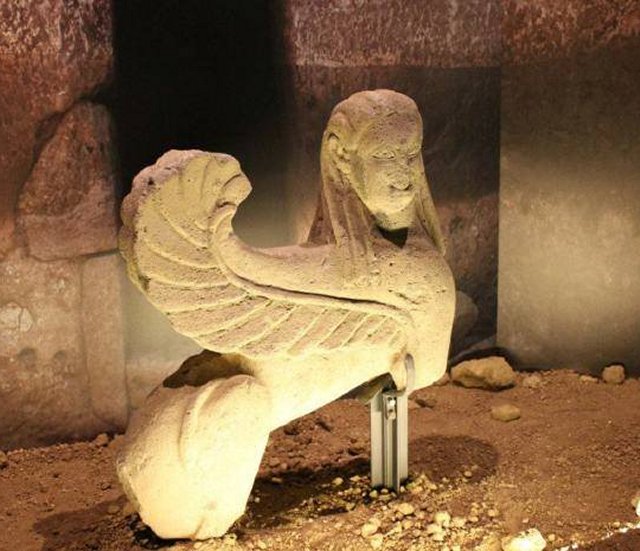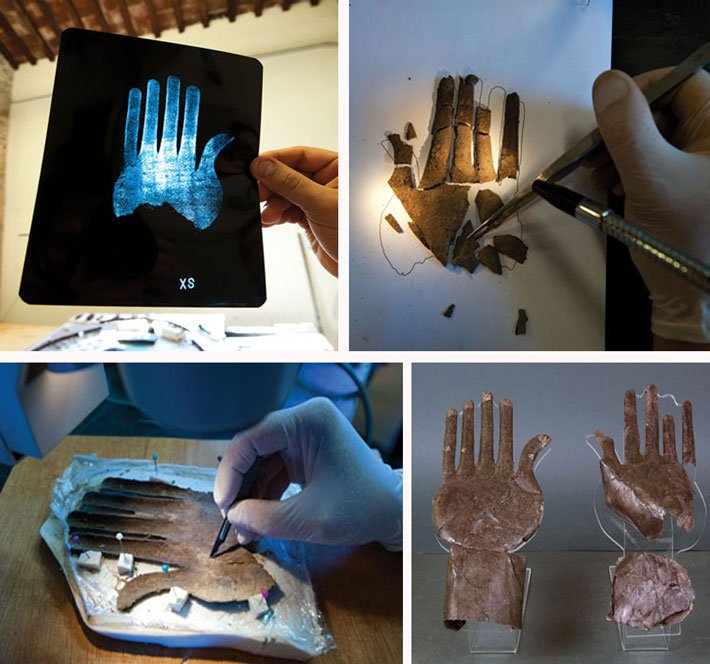Mystery Of The Silver Hands Discovered In An Etruscan Tomb Full Of Secrets
A. Sutherland - AncientPages.com - Italy's famous City Park of Vulci (Vulci Archaeological Naturalistic Park) north of Rome has its ancient secrets but at the same time gives the opportunity to travel through time in order to reach the Etruscans - one of the most enigmatic civilizations in Europe.
In the park - one of the most important centers of Ancient Etruria in central Italy - located about 75 miles northwest of Rome, there is an Etruscan and Ancient Roman city, and necropolis of Vulci, Osteria.
One the recent diggings revealed an Etruscan tomb that dates from the late 7th century BC.
The Tomb of The Sphinx, Park at Vulci, Italy.
The tomb is believed to have been that of a woman. The grave goods buried with the body are all intact. Archaeologists discovered painted beads, an iron fibula ancient brooch, jars and a bucchero in a Corinthian style – a bucchero is a type of ceramic black pot with a glossy surface made by the Etruscans," reported Italy Magazine in spring 2013.
Archaeologists also unearthed an Egyptian scarab at the site. The scarab depicts the falcon-headed Egyptian god Horus and is thought to date from 746 BC to 525 BC.
Several important discoveries have been made at Vulci. The necropolis, already known from the nineteenth century to the extraordinary funerary complexes brought to light, such as the "Tomb of the Sun and the Moon," the "Panathenaic", "Carved Ceilings" and a monumental burial, the "Tomb of the Sphinx", dating from the sixth century BC and unearthed at the end of the excavation.
The magnificent sculpture in nenfro depicting a sphinx, probably placed at the entrance of the tomb in order to protect the deceased and accompany them in the Hereafter.
The head of a second sphinx, from another tomb in the necropolis, an initial restoration has allowed us to identify traces of the original red color.
(Marco Merola)The silver hands were taken to a nearby laboratory. There (top row, left to right) researchers X-rayed them, fit the pieces of the right hand back together, and (bottom row, left to right) carefully cleaned the more intact left hand. The result: two completely restored and conserved hands.(Archaeology.org)
Archaeologist Carlo Casi, who manages the Vulci archaeological park on behalf of the local archaeological superintendency of Etruria Meridionale said:
"Tomb of the Sun and the Moon" was the most important funerary complex in the area, and we know the area was open for visitors until the middle of the nineteenth century."
"But since then it has literally been swallowed up by nature." Three years ago, Casi and his team set out to rediscover the "Tomb of the Sun and the Moon" using topographic maps of the area, some of which were drawn in the nineteenth century.
"Unfortunately, we weren't able to find the tomb again, probably because the people who drew the maps of the area made some errors in locating it."
However, yet another archaeologists extraordinary discovery was made when scientists encountered a most spectacular place, namely, "The Tomb of the Silver Hands", a monumental place, with a long corridor with an atrium open to the sky and leading to three burial chambers that contained the remains of at least three individuals.
This tomb must have belonged to high-ranking members of the Etruscan society regardless of their gender.
A freelance journalist Marco Merola wrote in his article:
"While excavating Chamber A, Casi noticed something unusual lying on the ground among a variety of artifacts—two well-preserved silver hands with traces of gold on the fingers and gold-plated fingernails,"
“I knew immediately that these hands had once been part of a sphyrelaton, a kind of wooden funerary dummy that represented the dead and guarded his or her soul after the body had been cremated,” says Casi. Most often the dummy represented a warrior or a nobleman, but in this case the figure was probably a woman."
The rare and fragile "Silver Hands" gave their name to the tomb, made with a foil of an alloy of silver and copper embossed with a slight gold leaf applied on the nails of three fingers.
Near the hands on the ground, the archaeologists also recovered some purple threads that they believe were used to tie gold studs to a brightly colored garment that once clothed the dummy.
They also found iron and bronze fibulae, little gold balls, pieces of faience, and amber and bone beads that likely were once part of several very fancy necklaces..."
Written by – A. Sutherland AncientPages.com Senior Staff Writer
Copyright © AncientPages.com. All rights reserved. This material may not be published, broadcast, rewritten or redistributed in whole or part without the express written permission of AncientPages.com
More From Ancient Pages
-
 On This Day In History: Alexander The Great Died In Babylon – On June 11, 323 BC
News | Jun 11, 2016
On This Day In History: Alexander The Great Died In Babylon – On June 11, 323 BC
News | Jun 11, 2016 -
 Man Finds Fascinating Mythical Treasure And Dies Under Mysterious Circumstances – Or Did Something Else Happen?
Featured Stories | Jan 26, 2025
Man Finds Fascinating Mythical Treasure And Dies Under Mysterious Circumstances – Or Did Something Else Happen?
Featured Stories | Jan 26, 2025 -
 Researchers Confirm Museum Shrunken Head As Human Remains
Archaeology | Aug 4, 2022
Researchers Confirm Museum Shrunken Head As Human Remains
Archaeology | Aug 4, 2022 -
 Oldest Indo-European Calendar Based On The Orion Constellation Is Engraved On A Vucedol Vessel
Artifacts | Jun 7, 2021
Oldest Indo-European Calendar Based On The Orion Constellation Is Engraved On A Vucedol Vessel
Artifacts | Jun 7, 2021 -
 Cherokee Gourd Rattles – Protection Against Evil Spirits And Other Danger
Ancient Traditions And Customs | Jun 7, 2019
Cherokee Gourd Rattles – Protection Against Evil Spirits And Other Danger
Ancient Traditions And Customs | Jun 7, 2019 -
 First Rare Evidence Of Biblical Purple From The Time Of King David And King Solomon
Archaeology | Jan 30, 2021
First Rare Evidence Of Biblical Purple From The Time Of King David And King Solomon
Archaeology | Jan 30, 2021 -
 Mystery Surrounds Newly Discovered Bronze Age Burial In Southwest England
Archaeology | May 21, 2018
Mystery Surrounds Newly Discovered Bronze Age Burial In Southwest England
Archaeology | May 21, 2018 -
 Quest For The Magical Healing Flower In The Garden Of Bakavali Led To A Love Story
Featured Stories | May 28, 2019
Quest For The Magical Healing Flower In The Garden Of Bakavali Led To A Love Story
Featured Stories | May 28, 2019 -
 Secrets Of The Uruk Prophecy Found In The Ancient Library Of A Magician With Divine Powers
Featured Stories | Mar 18, 2025
Secrets Of The Uruk Prophecy Found In The Ancient Library Of A Magician With Divine Powers
Featured Stories | Mar 18, 2025 -
 Hidden Double Message Discovered On Ancient Clay Tablet Gives A Disturbing Account Of The Great Flood
Archaeology | Dec 5, 2019
Hidden Double Message Discovered On Ancient Clay Tablet Gives A Disturbing Account Of The Great Flood
Archaeology | Dec 5, 2019 -
 Warrior King Eadberht Of Northumbria And A Four-Legged Beast Featured On Ancient Coin Discovered The Holy Island
Archaeology | Nov 11, 2021
Warrior King Eadberht Of Northumbria And A Four-Legged Beast Featured On Ancient Coin Discovered The Holy Island
Archaeology | Nov 11, 2021 -
 How Did A Rare 2,000-Year-Old Gem Seal Depicting God Apollo End Up In The City Of David?
Archaeology | Nov 5, 2020
How Did A Rare 2,000-Year-Old Gem Seal Depicting God Apollo End Up In The City Of David?
Archaeology | Nov 5, 2020 -
 Discovery Of An Unusually Large Ancient Artifact May Confirm Powerful Myth Of A Mysterious Race
Featured Stories | Oct 8, 2024
Discovery Of An Unusually Large Ancient Artifact May Confirm Powerful Myth Of A Mysterious Race
Featured Stories | Oct 8, 2024 -
 DNA From 35,000-Year-Old Romanian Skull Reveals Flaws In The Theory Of Evolution
Archaeology | May 25, 2021
DNA From 35,000-Year-Old Romanian Skull Reveals Flaws In The Theory Of Evolution
Archaeology | May 25, 2021 -
 Vindolanda Treasures: Rare Roman Cornu Mouthpiece – Instrument of War – Uncovered
Archaeology | Sep 24, 2022
Vindolanda Treasures: Rare Roman Cornu Mouthpiece – Instrument of War – Uncovered
Archaeology | Sep 24, 2022 -
 Poles conduct mural restoration in the villa buried by the ashes of Vesuvius
News | Aug 26, 2015
Poles conduct mural restoration in the villa buried by the ashes of Vesuvius
News | Aug 26, 2015 -
 How The Horseshoe Became A Symbol Of Good Luck
Ancient Idioms & Superstitions | Jan 28, 2017
How The Horseshoe Became A Symbol Of Good Luck
Ancient Idioms & Superstitions | Jan 28, 2017 -
 1,000-Year-Old Paintings Unearthed In Sudan – Documented By The Polish Researcher
Archaeology | Sep 25, 2022
1,000-Year-Old Paintings Unearthed In Sudan – Documented By The Polish Researcher
Archaeology | Sep 25, 2022 -
 Complex Of Goguryeo Tombs: Beautiful Ancient Wall Paintings Displaying History And Mythology Of North Korea
Civilizations | Oct 19, 2018
Complex Of Goguryeo Tombs: Beautiful Ancient Wall Paintings Displaying History And Mythology Of North Korea
Civilizations | Oct 19, 2018 -
 Prehistoric Evidence Of Sophisticated Prosthetics In Ancient Egypt – Artificial Toes Helped Egyptians Walk
Archaeology | Feb 20, 2014
Prehistoric Evidence Of Sophisticated Prosthetics In Ancient Egypt – Artificial Toes Helped Egyptians Walk
Archaeology | Feb 20, 2014






